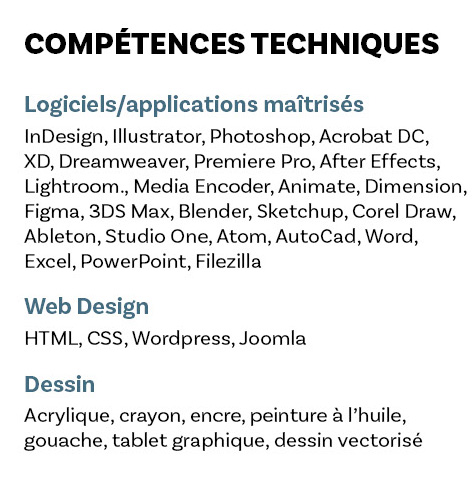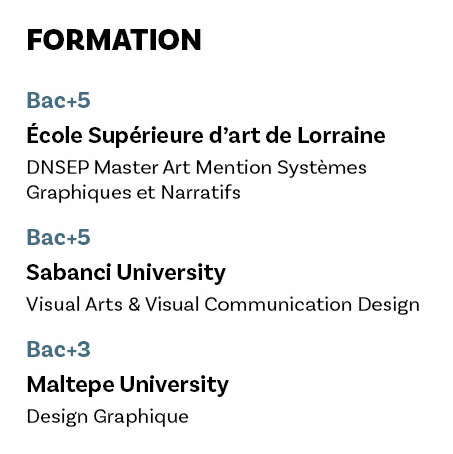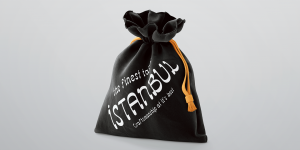As a graphic designer, your resume goes far beyond a simple listing of skills and professional experiences. It is a visual work in itself, a way to make a striking first impression on recruiters. Here is a comprehensive guide to help you design a CV that reflects your creativity and will captivate employers.
Layout: Creative and Professional Fusion
When you start designing your CV, the crucial step of layout requires strategic thinking. Choose a layout that skillfully blends creativity and professionalism, creating a captivating visual balance.
It's time to express your distinctive style. Incorporate subtle graphic elements that reflect your personal aesthetic. These visual touches offer an opportunity to convey your creativity at first glance.
However, don't forget that readability remains a top priority. Ensure that your layout, while creative, remains accessible and easy to navigate. Visual clarity ensures that recruiters can effectively absorb the crucial information on your CV.
By harmonizing creativity and professionalism in your layout, you create a visual canvas that not only grabs attention but also communicates your expertise in a professional manner. It’s an opportunity to showcase your ability to blend innovation with rigor, a valuable quality in the graphic design world.

Personal Information: First Impressions Matter
When you start creating your CV, display your contact information at the top of the page; a simple yet strategic move. This layout provides immediate accessibility for recruiters who wish to contact you quickly.
Add a striking header just below, capturing the essence of your professional identity. This often-overlooked element serves as the first impression, so make sure it reflects your expertise and style concisely.
Make sure that access to your online portfolio is clearly indicated. Integrate visible and functional links to guide recruiters to your work. This allows for a quick exploration of your achievements, thereby strengthening your credibility from the outset.
Don't forget to pay attention to typographic hierarchy. Use varying font sizes and styles to guide the reader's eye smoothly through the information. Thoughtfully crafted typographic hierarchy gives your CV a polished and professional appearance, making it easier to read and understand your background. By investing time in these details, you create a memorable and professional first impression that can spark recruiters' interest at first glance.

Professional Experience: Highlight Your Key Positions
When addressing the professional experience section, provide a clear chronological overview of your career. Highlight the key positions that have shaped your trajectory. Emphasize the main responsibilities and specific tasks of each role concisely, offering a clear overview of your expertise.
A personalized approach is crucial: tailor the description of each position according to the industry of the targeted company. Highlight the skills that specifically resonate with the requirements of the desired position. This attention to detail demonstrates not only your adaptability but also your deep understanding of the company's needs.
By following this methodology, your professional experience section becomes a dynamic narrative, highlighting your key positions and underscoring your significant contributions in various professional contexts.

A Clear List of Your Skills
In the section dedicated to your technical skills, focus on clarity and simplicity. Create a concise list highlighting the software you are proficient in, providing a quick overview of your expertise.
Directly list your specific skills, emphasizing the essential software in your field. This approach allows recruiters to quickly identify the technical skills you bring to the table.
For example:
- Adobe Creative Suite (Photoshop, Illustrator, InDesign)
- Sketch
- Figma
- Microsoft Office Suite
This clear and succinct list provides an immediate view of your operational capabilities, facilitating a quick understanding of your profile by recruiters.

Education: The Foundation of Your Expertise
When addressing the section dedicated to your academic background, use it as an opportunity to demonstrate how your educational foundation supports your career as a graphic designer. Highlight the relevant aspects of your academic journey that have directly contributed to your current expertise.
Don't forget to include relevant certifications or additional courses that have enriched your skills. These additions illustrate your ongoing commitment to staying at the forefront of emerging trends and technologies in the field of graphic design.
For example, if you have completed a certification in UX/UI design, mention it to demonstrate your adaptability to industry changes. By including these details, you establish a strong connection between your academic background and your professional career, providing recruiters with a comprehensive understanding of your educational and professional journey.

Revision and Personalization: The Final Touch
Carefully proofread your CV to avoid errors and ensure that the layout is consistent. Personalize your CV for each application, highlighting the most relevant skills and experience.
By following these tips, you will be able to create a graphic CV that captures the attention of recruiters while faithfully reflecting your creative talent. Remember that your CV is an extension of your portfolio, so make sure it authentically represents your style and expertise. Happy creating!




